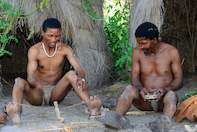The Central Kalahari is home to the Bushmen of Botswana. This unforgiving land has required the Bushmen to adapt to this challenging environment.

Kalahari, or Kgalagadi, loosely means the great dry place and refers principally to the vast sand plains of the Kalahari basin, The basin and wind-blown sand within it is a fairly recent geological phenomenon yet it constitutes the largest continuous sand deposit on the planet, stretching from northwestern South Africa to the Congo. The great sand surface lies across all of Botswana, with just a few granite koppies protruding, the only surface water being the celebrated Okavango-Linyanti-Chobe wetlands along its northern border.
There are more trees in the Kalahari than one would expect to find in such a dry place but in this seemingly endless aridness every tree is priceless. When the new settlers arrived with stock animals, the Bushmen could not comprehend how these strangers could chop down a shade tree for firewood or fence posts or understand their sense of ownership of land, Although
the Bushmen famously had scant regard for material possessions, they did have a sense of personal property. But this extended only to such things as water-filled ostrich eggs, which they hid along migration routes, honey hives and shade trees.
Today, as in the past, there is much to be done before the sun rises to its zenith and sears the land like a huge frying pan. The hottest summer days are reserved for conserving energy and body fluid. The clan will sit on mats in the shade and crack nuts, make arrows or eggshell beads. Water and firewood collecting will be done early or late, never in the heat of the day. A hunter will even abandon his quarry when he perceives the energy expended has
exceeded the food value of the prey.

